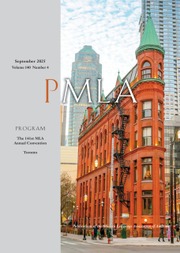No CrossRef data available.
Article contents
Negative Totalization
Published online by Cambridge University Press: 28 October 2025
Abstract
An abstract is not available for this content so a preview has been provided. Please use the Get access link above for information on how to access this content.

Information
- Type
- Theories and Methodologies
- Information
- Copyright
- © 2025 The Author(s). Published by Cambridge University Press on behalf of Modern Language Association of America
References
Works Cited
Ahmad, Aijaz. “Jameson’s Rhetoric of Otherness and the ‘National Allegory.’” 1987. In Theory: Classes, Nations, Literatures, Verso, 1992, pp. 95–112.Google Scholar
Chow, Rey. “Rereading Mandarin Ducks and Butterflies: A Response to the ‘Postmodern’ Condition.” Cultural Critique, no. 5, winter 1986–87, pp. 69–93.CrossRefGoogle Scholar
Combahee River Collective. “The Combahee River Collective Statement.” 1974. Library of Congress, www.loc.gov/item/lcwaN0028151/.Google Scholar
Bruyn, De, Eric, C. H. “Beyond the Line; or, A Political Geometry of Contemporary Art.” Grey Room, no. 57, fall 2014, pp. 24–49.CrossRefGoogle Scholar
Deleuze, Gilles, and Parnet, Claire. Dialogues. Vol. 2, translated by Hugh Tomlinson and Barbara Habberjam, Columbia UP, 1987.Google Scholar
Goyal, Yogita. “National Allegory and Beyond: Postcolonial Critique Now.” PMLA, vol. 137, no. 3, May 2022, pp. 521–28.Google Scholar
Jameson, Fredric. “Cognitive Mapping.” Marxism and the Interpretation of Culture, edited by Nelson, Cary and Grossberg, Lawrence, U of Illinois P, 1988, pp. 347–57.Google Scholar
Jameson, Fredric. The Political Unconscious: Narrative as a Socially Symbolic Act. Cornell UP, 1981.Google Scholar
Jameson, Fredric. Postmodernism; or, The Cultural Logic of Late Capitalism. Verso, 1992.10.1215/9780822378419CrossRefGoogle Scholar
Jameson, Fredric. “Third-World Literature in the Era of Multinational Capitalism.” Social Text, no. 15, autumn 1986, pp. 65–88.10.2307/466493CrossRefGoogle Scholar
Jameson, Fredric, et al. “Discussion.” Marxism and the Interpretation of Culture, edited by Nelson, Cary and Grossberg, Lawrence, U of Illinois P, 1988, pp. 358–60.Google Scholar
Mufti, Aamir R. “Zarina Hashmi and the Arts of Dispossession.” The Migrant’s Time: Rethinking Art History and Diaspora, edited by Mathur, Saloni, Sterling and Francine Clark Art Institute, 2011, pp. 174–95.Google Scholar
Mufti, Aamir R.. “Zarina’s Language Question.” Zarina: Paper like Skin, edited by Allegra Pesenti et al., Hammer Museum, 2012, pp. 151–58.Google Scholar
Tally, Robert T. Fredric Jameson: The Project of Dialectical Criticism. Pluto Press, 2014.Google Scholar
Zupančič, Alenka. “A Short Essay on Conspiracy Theories.” Objective Fictions: Philosophy, Psychoanalysis, Marxism, edited by Adrian Johnston, Edinburgh UP, 2021, pp. 232–49.CrossRefGoogle Scholar

